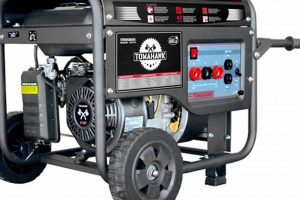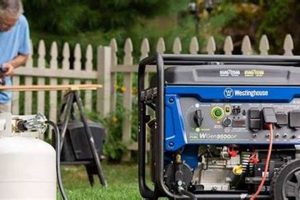Powering portable generators with natural gas offers a convenient alternative to gasoline or propane. This involves connecting a generator designed for natural gas or a dual-fuel model to a home’s existing natural gas line through an approved connection kit and transfer switch. This setup provides a continuous fuel supply, eliminating the need for refueling and ensuring uninterrupted power during outages.
Utilizing a readily available fuel source like residential natural gas provides significant advantages in emergency preparedness. It eliminates the hazards and logistical challenges of storing flammable liquids, offering a safer and more reliable power solution. Historically, generators relied heavily on gasoline, but the shift towards cleaner and more accessible fuels like natural gas reflects a growing demand for sustainable and convenient energy solutions. This approach simplifies long-term power backup, particularly during extended grid failures.
This article will further explore the practical aspects of natural gas-powered portable generators, including installation procedures, safety considerations, cost analysis, and environmental impact. It will also address the technical requirements and regulatory compliance associated with integrating these generators into a home’s power system.
Tips for Utilizing Natural Gas for Portable Generators
Safe and efficient operation requires careful planning and adherence to established guidelines. The following tips provide crucial information for homeowners considering natural gas as a fuel source for portable generators.
Tip 1: Professional Installation is Crucial: Natural gas connections should only be established by qualified professionals. Improper installation can lead to dangerous gas leaks and potential explosions.
Tip 2: Select an Appropriate Generator: Ensure the generator is specifically designed for natural gas or is a dual-fuel model capable of handling both natural gas and gasoline.
Tip 3: Proper Ventilation is Essential: Generators produce carbon monoxide, a colorless, odorless, and poisonous gas. Operate the generator outdoors in a well-ventilated area, away from windows and doors.
Tip 4: Regular Maintenance is Key: Schedule routine maintenance to ensure optimal generator performance and prevent malfunctions. This includes oil changes, air filter replacements, and spark plug inspections.
Tip 5: Understand Local Codes and Regulations: Consult local authorities regarding permits and inspections required for natural gas generator installations. Compliance with regulations ensures safety and prevents legal issues.
Tip 6: Consider a Transfer Switch: A properly installed transfer switch isolates the generator’s power from the utility grid, preventing backfeeding and protecting utility workers.
Tip 7: Calculate Fuel Consumption: Estimate the generator’s natural gas consumption to anticipate fuel costs and ensure an adequate supply during extended outages.
Adhering to these guidelines ensures safe and efficient operation, enabling homeowners to leverage the advantages of natural gas while mitigating potential risks.
By following these recommendations, consumers can confidently integrate natural gas portable generators into their emergency preparedness plans, ensuring a reliable and sustainable power source during unforeseen disruptions.
1. Fuel Source
Utilizing natural gas as a fuel source for portable generators offers distinct advantages compared to traditional gasoline or propane. The continuous fuel supply from a home’s existing natural gas line eliminates the need for refueling, a critical benefit during extended power outages. This connection between natural gas as a fuel source and generator operation is fundamental to understanding the system’s value proposition. A homeowner experiencing a multi-day power outage, for example, gains uninterrupted power without the logistical challenges of gasoline procurement and storage. This contrasts sharply with gasoline-powered generators, which require periodic refueling, potentially interrupting critical services during an outage.
The practical significance of using natural gas extends beyond mere convenience. Safety is enhanced by eliminating the storage of flammable liquids, reducing fire hazards. Furthermore, natural gas generators contribute to a cleaner environment by producing fewer emissions than gasoline counterparts. Cost considerations also favor natural gas in many regions, offering a potentially more economical long-term solution compared to fluctuating gasoline prices. For instance, a household relying on a natural gas generator during peak electricity demand periods could realize substantial cost savings compared to using grid electricity.
The integration of a natural gas fuel source with a portable generator presents a compelling alternative for backup power. While professional installation and adherence to safety regulations are essential, the benefits of a continuous, clean, and potentially cost-effective fuel source offer significant advantages. This approach represents a shift toward more sustainable and reliable emergency power solutions, reducing reliance on finite, volatile fuels and enhancing household preparedness.
2. Portability and Convenience
The portability of natural gas-powered generators might appear paradoxical, given the need for a fixed fuel source. However, portability in this context refers to the generator’s mobility within the property, not complete independence from external resources. Unlike permanently installed standby generators, portable units offer flexibility in placement and usage. This distinction allows users to position the generator strategically, powering essential circuits or appliances based on immediate needs. For instance, during a power outage, a portable generator can be moved to power a refrigerator in the garage or a sump pump in the basement, offering tailored power delivery not readily achievable with fixed systems.
The convenience of natural gas as a fuel source complements the portability factor. Eliminating the need to transport and store gasoline or propane simplifies generator operation and reduces logistical burdens, particularly during emergencies. This convenience translates to enhanced preparedness, as homeowners can readily deploy their generators without concerns about fuel availability. Consider a scenario where a winter storm disrupts power and access to gas stations. A natural gas-powered portable generator provides immediate, reliable power without the risks associated with venturing out in hazardous conditions to procure fuel.
While a natural gas connection necessitates a degree of proximity to the home’s gas line, portable generators offer significant advantages over both fixed generators and those reliant on stored fuels. The ability to relocate the generator as needed combined with the uninterrupted fuel supply inherent in a natural gas connection provides a practical and adaptable solution for backup power. This combination of portability and convenience empowers homeowners to manage power outages effectively, minimizing disruption and maximizing safety.
3. Connection and Installation
Establishing a safe and functional connection between a portable generator and a natural gas supply requires meticulous attention to detail and adherence to established safety protocols. This process is distinct from simply refueling a gasoline-powered generator and represents a critical component of operating a natural gas-powered portable generator. The connection typically involves a flexible fuel line and a quick-disconnect fitting, allowing for relatively easy detachment when the generator is not in use. However, the initial installation of the necessary gas piping and connection points should always be performed by a qualified professional. Incorrect installation can lead to gas leaks, posing significant safety risks. A crucial aspect of this process is ensuring a gas-tight seal to prevent leaks and maintain the integrity of the fuel system.
Beyond the physical connection, proper installation also encompasses considerations for generator placement and ventilation. Generators produce carbon monoxide, a colorless and odorless gas that can be fatal if inhaled. Therefore, adequate ventilation is paramount. Generators should never be operated indoors, in garages, or in enclosed spaces. Positioning the generator outdoors, away from windows and doors, and ensuring proper airflow around the unit minimizes the risk of carbon monoxide poisoning. For instance, placing a generator too close to a house with open windows could allow carbon monoxide to enter the dwelling, posing a serious health hazard. Additionally, local codes and regulations may dictate specific requirements for generator placement and installation, and compliance with these regulations is essential for both safety and legality. These regulations might stipulate minimum distances from structures, specific ventilation requirements, or the use of approved connection components.
The connection and installation process forms the foundation for safe and reliable operation of a natural gas-powered portable generator. Professional installation, adherence to safety protocols, and compliance with local regulations are non-negotiable aspects of utilizing this power source. Overlooking these critical steps can compromise safety and negate the inherent advantages of natural gas as a convenient and reliable fuel. Understanding and implementing proper connection and installation procedures not only mitigates risks but also ensures the long-term functionality and effectiveness of the generator, providing homeowners with a dependable power solution during emergencies and planned outages.
4. Safety and Ventilation
Operating a portable generator fueled by natural gas requires stringent adherence to safety protocols, particularly concerning ventilation. Combustion engines, regardless of fuel type, produce exhaust gases, including carbon monoxide (CO). CO is a colorless, odorless, and highly toxic gas. Insufficient ventilation during generator operation can lead to a dangerous accumulation of CO, posing significant health risks, even fatalities. The connection between safe operation and adequate ventilation is inextricable; one cannot exist without the other. A failure to provide proper ventilation effectively transforms the generator into a potential source of lethal fumes. For example, operating a generator inside a garage, even with the door open, can create a CO trap, leading to rapid accumulation of the gas. Similarly, placement near open windows or air intakes can draw exhaust fumes into living spaces, exposing occupants to dangerous levels of CO.
Practical application of safety principles necessitates a comprehensive understanding of ventilation dynamics. Generators should always be placed outdoors, far from windows, doors, and air intakes. A minimum distance of 20 feet from any structure is generally recommended, though greater distances are preferable. Wind direction should also be considered, ensuring exhaust fumes are directed away from occupied areas. Further enhancing safety, CO detectors should be installed in areas near generator operation. These devices provide an early warning system, alerting occupants to the presence of CO before dangerous levels are reached. For instance, a CO detector placed near a back patio where a generator operates during a power outage could save lives by providing timely notification of accumulating CO. These detectors should be tested regularly to ensure proper functionality.
Prioritizing safety and ventilation is paramount when operating a natural gas-powered portable generator. Understanding the inherent dangers of CO poisoning and implementing appropriate ventilation strategies mitigates these risks. Consistent adherence to safety guidelines, including proper generator placement and the use of CO detectors, ensures safe and effective utilization of this essential power source. Ignoring these precautions can have dire consequences, transforming a valuable tool into a life-threatening hazard. Vigilance and informed operation are crucial for maximizing the benefits of portable generators while safeguarding the well-being of individuals and communities.
5. Maintenance and Longevity
The longevity of a natural gas-powered portable generator and its consistent performance are directly linked to a comprehensive maintenance regimen. Regular maintenance is not merely a recommendation but a critical factor influencing the generator’s lifespan and reliability. Neglecting routine maintenance can lead to premature wear, reduced efficiency, and potentially catastrophic failures, especially during critical periods like power outages. The connection between maintenance and longevity is a fundamental principle of generator ownership, regardless of fuel type. For instance, failing to change the oil regularly can lead to increased engine wear and eventual seizure, rendering the generator useless precisely when it’s needed most. Similarly, neglecting air filter maintenance can restrict airflow, reducing power output and increasing fuel consumption.
A structured maintenance schedule should encompass several key tasks. Regular oil changes, using the manufacturer’s recommended oil type and viscosity, are crucial for lubricating engine components and preventing excessive wear. Air filter replacement at prescribed intervals ensures optimal airflow, promoting efficient combustion and maximizing power output. Spark plug inspection and replacement, as needed, contribute to reliable ignition and consistent engine performance. Beyond these fundamental tasks, periodic checks of fuel lines and connections for leaks or damage are essential for safe and reliable operation. For example, a small crack in a fuel line might go unnoticed during routine operation but could become a significant leak under the increased stress of extended use during a power outage, potentially leading to a fire hazard. Additionally, consulting the manufacturer’s specific maintenance recommendations for the particular generator model ensures all critical components receive appropriate attention.
Consistent maintenance practices safeguard the generator investment and ensure reliable performance when power is most critical. A well-maintained generator offers not just peace of mind but also tangible benefits in terms of extended lifespan, efficient operation, and reduced risk of unexpected failures. Understanding and implementing a proactive maintenance schedule is essential for maximizing the value and dependability of a natural gas-powered portable generator, transforming it from a simple appliance into a reliable source of power during unforeseen circumstances. Ignoring these crucial steps jeopardizes the generator’s functionality and potentially compromises safety, highlighting the inextricable link between regular maintenance and sustained, reliable performance.
6. Cost and Efficiency
Analyzing the cost and efficiency of operating a portable generator on natural gas requires considering both the initial investment and long-term operational expenses. The purchase price of a natural gas-ready generator, including necessary connection equipment and professional installation, typically exceeds that of comparable gasoline-powered models. This upfront cost difference reflects the specialized components required for safe and compliant natural gas integration. However, the long-term operational costs often present a different picture. Natural gas prices, generally lower and more stable than gasoline, can lead to significant savings over time, especially during extended operation or frequent power outages. For instance, a homeowner experiencing several multi-day power outages annually might find the lower fuel costs of natural gas offset the higher initial investment within a few years. Furthermore, the elimination of gasoline storage, with its inherent risks and potential for fuel degradation, represents an indirect cost saving and safety enhancement.
Efficiency considerations extend beyond fuel costs. Natural gas generators generally operate with lower emissions than gasoline counterparts, contributing to a smaller environmental footprint. This reduced environmental impact can be quantified through lower carbon dioxide emissions and reduced reliance on finite fossil fuels. Moreover, the continuous fuel supply from a residential natural gas line enhances operational efficiency by eliminating the need for refueling during extended outages. This uninterrupted operation is crucial for critical applications like powering medical equipment or sump pumps, where continuous power is essential. For example, during a flood event accompanied by a power outage, a natural gas-powered generator can operate continuously, ensuring the sump pump functions effectively and prevents basement flooding, mitigating potentially significant property damage. This contrasts sharply with a gasoline-powered generator, requiring periodic refueling interruptions that could compromise flood protection.
Assessing the cost and efficiency of natural gas-powered portable generators necessitates a holistic perspective, encompassing initial investment, long-term operating costs, environmental impact, and operational reliability. While the upfront costs may be higher, the potential for long-term savings, reduced emissions, and uninterrupted operation presents a compelling case for natural gas as a fuel source. This approach requires careful evaluation of individual circumstances, including frequency of power outages, local fuel costs, and environmental priorities. Understanding these factors empowers informed decision-making, enabling homeowners to select the most cost-effective and efficient power solution for their specific needs. The long-term benefits often outweigh the initial investment, particularly for users prioritizing uninterrupted operation, environmental responsibility, and long-term cost savings.
7. Regulations and Codes
Operating a portable generator fueled by natural gas involves navigating a landscape of regulations and codes designed to ensure safety and prevent hazards. These regulations, often varying by jurisdiction, govern installation procedures, ventilation requirements, connection specifications, and permitted usage scenarios. Compliance with these codes is not merely a legal obligation but a critical factor in safeguarding lives and property. Ignoring these regulations can lead to dangerous situations, including gas leaks, fires, and carbon monoxide poisoning. Understanding and adhering to applicable regulations is essential for responsible and safe generator operation.
- Permitting and Inspections
Many jurisdictions require permits for installing natural gas-powered generators. These permits ensure installations meet specific safety standards and comply with local building codes. Inspections, often conducted before and after installation, verify adherence to these standards. For example, a permit might specify the required distance between the generator and the house, the type of piping allowed, and the necessary ventilation provisions. These requirements aim to minimize risks associated with gas leaks, improper ventilation, and potential fire hazards.
- Connection Requirements
Regulations often dictate specific requirements for connecting a portable generator to a natural gas supply. These requirements may specify approved connection methods, materials, and safety devices. For instance, using unapproved flexible fuel lines or failing to install a quick-disconnect device might violate local codes, potentially leading to gas leaks or unsafe operating conditions. Adherence to these connection requirements ensures the integrity of the fuel system and minimizes the risk of accidents.
- Ventilation Standards
Ventilation regulations address the critical issue of carbon monoxide poisoning. Codes typically specify minimum distances between the generator and structures, mandated airflow requirements, and the placement of carbon monoxide detectors. These regulations aim to prevent the accumulation of dangerous levels of carbon monoxide. For example, a code might require a minimum 20-foot distance between the generator and any building opening, ensuring adequate dispersion of exhaust gases. Non-compliance can lead to serious health consequences, highlighting the critical importance of adherence to ventilation standards.
- Usage Restrictions
Some jurisdictions impose limitations on generator usage, particularly during specific hours or under certain environmental conditions. These restrictions might aim to minimize noise pollution or reduce emissions during periods of high air quality concern. For example, a local ordinance might prohibit generator operation during nighttime hours to minimize noise disturbance for neighbors. Understanding and complying with these usage restrictions ensures responsible generator operation and fosters positive community relations.
Navigating the regulatory landscape associated with natural gas-powered portable generators is a crucial aspect of responsible ownership. Understanding and adhering to these codes and regulations, including permitting requirements, connection specifications, ventilation standards, and usage restrictions, ensures safe and compliant operation. Failure to comply not only jeopardizes safety but also potentially incurs fines and legal penalties. By prioritizing compliance, generator owners contribute to a safer environment and demonstrate responsible stewardship of this valuable power resource.
Frequently Asked Questions
This section addresses common inquiries regarding the operation of portable generators using natural gas as a fuel source.
Question 1: Is professional installation required for connecting a portable generator to a home’s natural gas line?
Yes, professional installation by a qualified technician is mandatory. Improper installation can lead to dangerous gas leaks, posing significant safety risks.
Question 2: Can any portable generator operate on natural gas?
No. Generators must be specifically designed for natural gas or be dual-fuel models capable of using both natural gas and gasoline. Using a gasoline-only generator with natural gas is extremely dangerous.
Question 3: What safety precautions are essential when operating a natural gas generator?
Adequate ventilation is paramount. Generators should always be operated outdoors, far from windows, doors, and air intakes, to prevent carbon monoxide poisoning. Carbon monoxide detectors are also recommended.
Question 4: How does the cost of operating a natural gas generator compare to using gasoline?
While the initial investment for a natural gas generator might be higher, operational costs are often lower due to the typically lower price of natural gas compared to gasoline. Long-term cost-effectiveness depends on usage and local fuel prices.
Question 5: Are there any regulatory requirements for using a natural gas generator?
Yes. Local codes and regulations often govern installation, ventilation, and permitted usage. Permits and inspections might be required. Consulting local authorities is essential for compliance.
Question 6: What maintenance is required for a natural gas generator?
Regular maintenance, including oil changes, air filter replacements, and spark plug inspections, is essential for optimal performance and longevity. Refer to the manufacturers recommendations for specific maintenance intervals.
Careful consideration of these frequently asked questions provides a foundational understanding of safe and effective natural gas generator operation. Prioritizing safety, adhering to regulations, and performing regular maintenance ensures reliable performance and mitigates potential risks.
The subsequent sections will delve deeper into specific aspects of natural gas generator operation, providing comprehensive guidance for informed decision-making and responsible usage.
Conclusion
Operating a portable generator on natural gas offers a compelling alternative to traditional gasoline-powered units. This comprehensive exploration has highlighted the key considerations, encompassing safe installation procedures, essential ventilation requirements, cost analysis, maintenance practices, and adherence to applicable regulations. The advantages of a continuous fuel supply, reduced emissions, and potential long-term cost savings position natural gas as a viable and often preferable option for backup power. However, the importance of professional installation, rigorous adherence to safety protocols, and diligent maintenance cannot be overstated. These factors are crucial for mitigating risks and ensuring reliable performance.
Reliable backup power is paramount in an increasingly unpredictable world. Informed decision-making regarding power solutions requires careful evaluation of individual needs, environmental considerations, and long-term cost implications. Running a portable generator on natural gas presents a compelling solution, offering a blend of convenience, sustainability, and reliability. Thorough planning, professional guidance, and responsible operation ensure this valuable resource provides dependable power when needed most, safeguarding homes, families, and essential services.





